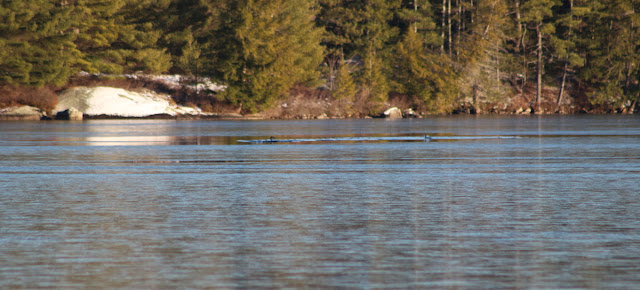It's now officially winter by any measure - would someone please tell the loons?
But first, the solstice. I took a hike up to Crockett's Ledge to watch the sunrise on the shortest day of the year. I have watched sunrise from this vantage point before, but always in the summer, and I was curious to see just how much farther south the sun rises at the winter solstice. I found that it comes up directly behind 2382' high Belknap Mountain which delayed the sun's appearance until 15 minutes after official sunrise.
 |
| At Crockett's Ledge in December, the sun rises directly behind Mt. Belknap. |
This made sunrise less colorful than in summer because the sun was relatively high in the sky when it breached the mountain. But it did make for a really neat scene:
 |
| The sun crests the south flank of Belknap while snow blows on the north flank of Gunstock. |
Gunstock ski area was making snow overnight and the plume of snow from the snow guns was backlit by the rising sun right on schedule for sunrise. Just by luck I also captured an airplane flying between the two mountains at that moment.
When I see Belknap Mountain from a distance I often note the fire tower on the summit. But seeing the mountain that morning in silhouette reminds me that I'm actually seeing the radio tower near the summit, not the fire tower. The fire tower (the small bump to the left of the radio tower) is now just barely above the tree tops while the much higher radio tower protrudes well above the tree line.
Now to the loons. Even with temperatures dropping to ten degrees the past two nights, our loon chick Maddie is still here.
 |
| One stubborn and foolish teenager. |
 |
| Over 90 percent of the lake was iced over on Wednesday. |
 |
| Our two loons in a tiny patch of open water. |
On Thursday the situation was no better and John Cooley from the Loon Preservation Committee came to assess the situation and determine whether a rescue was needed or feasible. In order to execute a rescue there needs to be at least an inch of ice so a small, flat bottom boat can be taken out to where the loons are trapped in a small enough open area (30 to 40 feet) that they can be netted without them swimming away.
 |
| My last sighting of our two loons amidst the frozen lake. |
The decision was to wait until after Friday's warm rain event to see if enough water opened up for them to be able to take flight in case they finally decide it's time to move on. And the drama was heightened on Friday by the arrival of predators. Amy and Russ reported two juvenile bald eagles were sitting on the ice perusing the two stranded loons, which were very agitated by the eagles' presence. They reported the loons would come up, take a quick look around then dive back down. At one point two mature eagles arrived and were devouring what appeared to be a large bird they had captured - but not one of our loons, as they were both still in the water.

















































